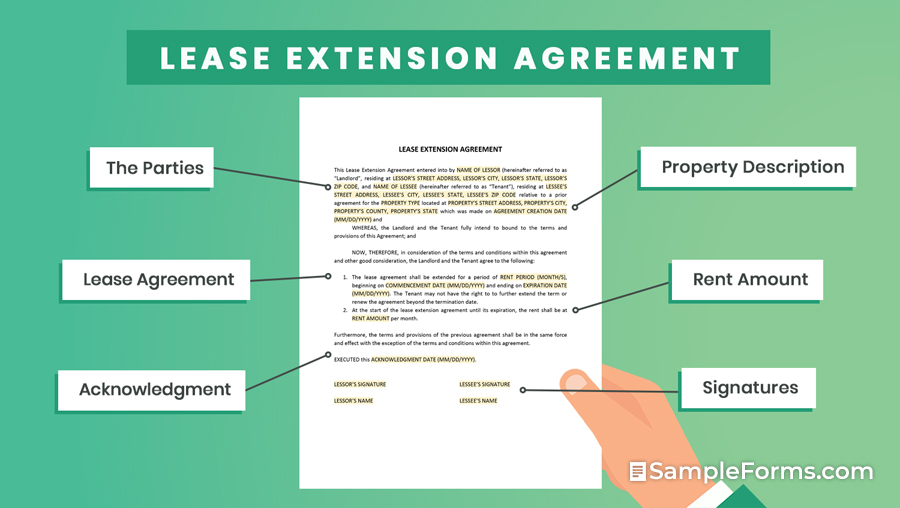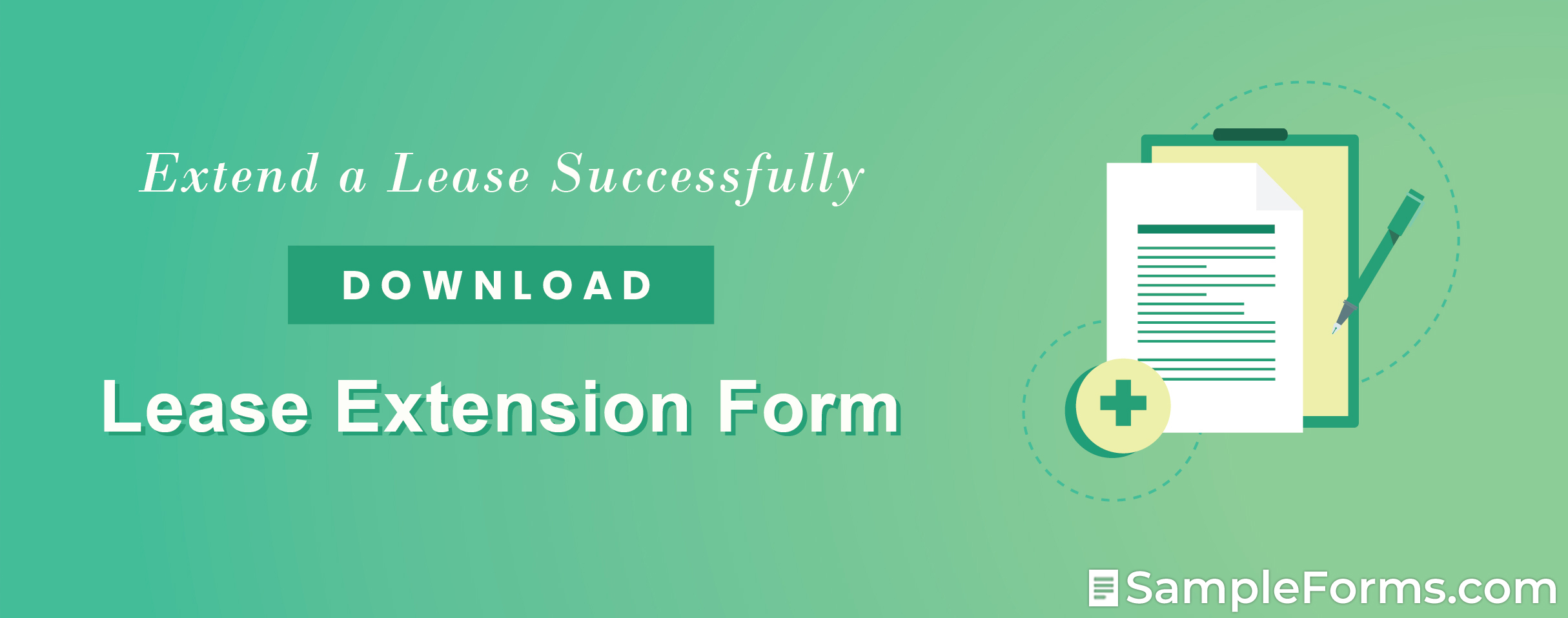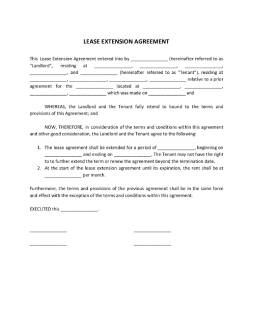- Eviction Notice Forms
- Power of Attorney Forms Forms
- Bill of Sale (Purchase Agreement) Forms
- Lease Agreement Forms
- Rental Application Forms
- Living Will Forms Forms
- Recommendation Letters Forms
- Resignation Letters Forms
- Release of Liability Agreement Forms
- Promissory Note Forms
- LLC Operating Agreement Forms
- Deed of Sale Forms
- Consent Form Forms
- Support Affidavit Forms
- Paternity Affidavit Forms
- Marital Affidavit Forms
- Financial Affidavit Forms
- Residential Affidavit Forms
- Affidavit of Identity Forms
- Affidavit of Title Forms
- Employment Affidavit Forms
- Affidavit of Loss Forms
- Gift Affidavit Forms
- Small Estate Affidavit Forms
- Service Affidavit Forms
- Heirship Affidavit Forms
- Survivorship Affidavit Forms
- Desistance Affidavit Forms
- Discrepancy Affidavit Forms
- Career Assessment - 16+ Examples, Format, Tips, Pdf Forms
- Undertaking Affidavit Forms
- General Affidavit Forms
- Affidavit of Death Forms
Lease Extension Form
Leasing became the preferred option in acquiring a home because of its lower costs and particular lease terms. One term can run for several months or years. As the termination date of the lease draws near, both the landlord and tenant have two options. One is to fully terminate the contract or to extend the agreement by handing in a lease extension form. That is why lease extensions are common among residential leases. These forms are also used to extend the lease of equipment, vehicle, and machinery. Read More
Lease Extension Form
What is a Lease Extension Form?

Just like a lease agreement, a lease extension form is also a legal and binding document that allows the extension of the aforementioned agreement. The request for an extension is possible when the prior arrangement is about to expire. Extensions are not necessary but it is highly possible when the proper measures are followed. A lease extension contains existing and new information that will make the extension possible. It primarily highlights the changes regarding the lease term. The other terms and conditions of the prior arrangement remain in force and valid.
How Do You Write a Lease Extension Form?
One mistake that tenants make is assuming that they can extend their lease without signing anything. They assume that they can just talk with the landlord to make the changes. Even if the landlord agrees to the verbal request, it is not an assurance that the landlord will abide by that claim. The tenant does not have a hold to make the landlord liable either. Thus, written and signed forms are necessary. Aside from merely mentioning the shift of the lease term, there are other details that are needed in a lease extension form.
1. Discuss With the Landlord
Before starting your lease extension form, discuss your intention for an extension with the landlord first. The landlord may have different plans for the leased property that will hinder your plan for an extension. On the other hand, the landlord may approach the tenant first and discuss the possibility of the extension. Generally, the call for having an extension falls to the intention of either party.
2. Review the Basic Terms of the Agreement
The basic terms of the lease agreement comprise the first part of the extension form. This part basically presents the parties involved. The fundamental details of both the landlord and the tenant, which includes their legal names and the mailing address of the landlord. Furthermore, the details of the property are also mentioned. Including its property type and its exact address.
3. Present the Appeal
The next part of the form contains the technicalities of the extension. It asks for both the commencement and expiration date of the suggested extension. This stipulation also asks for the rental fee for the additional month. One might question why there is a need to mention the rental fee again when the form enforces all the terms from the prior agreement. This is because there are instances when the rental fee can increase or decrease according to the situation or to the decision of the landlord.
4. Reiterate the Validity of the Previous Contract
Although it is common knowledge that the extension still requires both parties to follow the existing terms and conditions, it is important to state it in the lease extension form. The statement bearing that the lease continues to abide by the terms of the previous contract makes it formal and official. Either party continues to be bind by their responsibilities and obligations from the former arrangement.
5. Review and Sign the Form
A lease extension form is a short and straightforward form. It is a collaboration of both old and brand new information to include a modification of a previous engagement. Regardless of its direct nature, both parties must review the stipulations of the form. Both should make sure that the details are all accurate and factual before they affix their signatures. Once both parties are able to sign the document, it makes the new arrangement enforceable and will be acted out on the mentioned commencement date.
FAQs
What is the difference between lease renewal and lease extension?
A lease extension continues the landlord-tenant relationship stemming from the prior agreement. But, lease renewal is technically a new and separate lease agreement. Even when the same parties are involved, a lease renewal creates a separate and distinct landlord-tenant relationship.
Can the landlord disapprove of an extension appeal?
Of course. The landlord has all the right to disapprove of the tenant’s appeal for an additional month on top of the agreed lease term. The landlord can have different reasons, but one of the most common reasons is when the tenant has caused trouble during their stay. Another plausible reason is when the landlord is already expecting someone else to lease the property.
What will happen to the nature of the lease agreement during an extension?
If the lease extension is approved, the nature of the agreement transforms into a month-to-month or periodic lease. This makes it possible for the tenant to file for another extension for the next month.
Are lease extensions good decisions?
Lease extensions are best for people who are still looking for better deals and better choices.
Can I choose to buy the property once my lease is over?
Buying the property upon the end of the lease is only possible when the landlord willingly asks you if you are interested. Basically, it is possible if the landlord or owner allows it.
Leased properties are the perfect options for people who are looking for great places to stay without breaking the bank. Consequently, people are taking their time in choosing a place to live in for the next months or years. For those who like to take their sweet time, lease extension forms often come in handy when their previous lease agreement is near its expiration and they don’t have other plans yet. So, even if you have not experienced this situation yet, make sure to acquaint yourself with how a lease extension form works.

